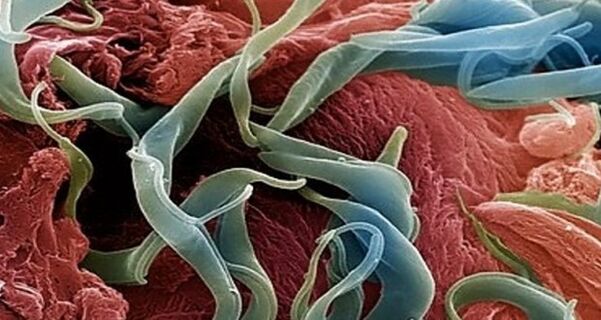
People and animals are attacked by these creatures, the infection can easily be transmitted by infected products, water and dirty hands.The development of parasites in the body will help prevent the prevention and careful compliance with personal hygiene, but even these measures do not guarantee a 100 % protection.Helminers who live in the human body can live in different organs, differ in appearance, size and the degree of damage that has been inflicted to a person.
Parasites in the human body
How many situations are there when a person runs through doctors for years and do not get rid of allergies, treat asthma, sugar -down drugs and all drink without success?Each of us has acquaintances who spent large quantities for the treatment of different diseases and have not achieved any result.
Only in rare cases, if the doctor is either very intelligent or very responsible, does he lead such a patient to a regular analysis of feces and then ... Then parasites can be found in the human body that cause dozens of diseases and with which nobody struggles in the treatment of these pathologies.
In contrast to the specified opinion, worms in the intestine are not necessarily "prescribed" and can be determined by a banal analysis of feces.Many parasites feel great in lungs, heart, muscles, also in the brain and in the eyes.
The well -known malaria, which was once defeated, has returned and this is the most dangerous parasitic illness in the opinion of experts.Malarial plasmodium only lives in the blood and not every doctor can recognize this disease with sufficient trust.
How parasites fall into the human body
They fall into the human body in different ways, the most common is due to the use of infected water and food.
Grape eggs stay up to 6 months and toys, carpets, underwear and pastel linen through toys, carpets.Askarid eggs come to us through poorly washed vegetables and fruit.Grill or homemade lard is a 95% guarantee for infection with trichinellosis.
Parasites penetrate into us with insect bites when they bathe through air in fresh water reservoirs, with dust that is a carrier of eggs.
Salt fish, stroganine or caviar are the cause of infections with adhesive tapeworms, the length of which reaches 12 meters and which can live in their body under 25 years.Cases of infections of infants have become more common in parasites in the womb.With their wet breathing, dogs and cats can dissolve parasite eggs at a distance of up to 5 meters.
You can infect your own, but also sellers, chefs, waiters and parasites through dirty hands, but also sellers, chefs and parasites, travel with money and handrails of public transport.A high concentration of parasite eggs is observed in products, such as:
Epidemiologists around the world try to fight this misfortune.In the United States, for example, for checking for Helminthias, 1 pork is destroyed in every thousand.This develops with multimillion dollars -but otherwise it is impossible.
There are no absolutely reliable ways to disinfect meat, and the ordinary culinary processing of larvae does not destroy.You cannot guarantee how the purity of your food by welding or roasting meat penetrates a large number of parasite larvae into your body.
In which organs can a person live in parasites
Helminthian parasites are divided into two categories that correspond to the activity location in the body of the donor:
- Cramp: Worms that live in different gastrointestinal sections.There are about 100 types of intestinal parasites, and there are some dozen species for each intestinal department.The small intestine is ready to take ascaris, antelost, wide ribbons and other less frequent "brothers".The small intestine will "share" the living space with pinworms, a dwarf chain and the rest.Medical literature describes cases in which a person was infected with different types of parasites at the same time.
- Material:Worms that are located in organs and even located in the blood.Modern medicine is successful with paragonosis (lungs), the cystycche (brain), echinococcosis (liver) and phylairiosis (lymphatic vessels).Some worms of worms move through the blood system through the body and happen to be bound to every organ.When many eggs have been inserted, the whole body can be infected.
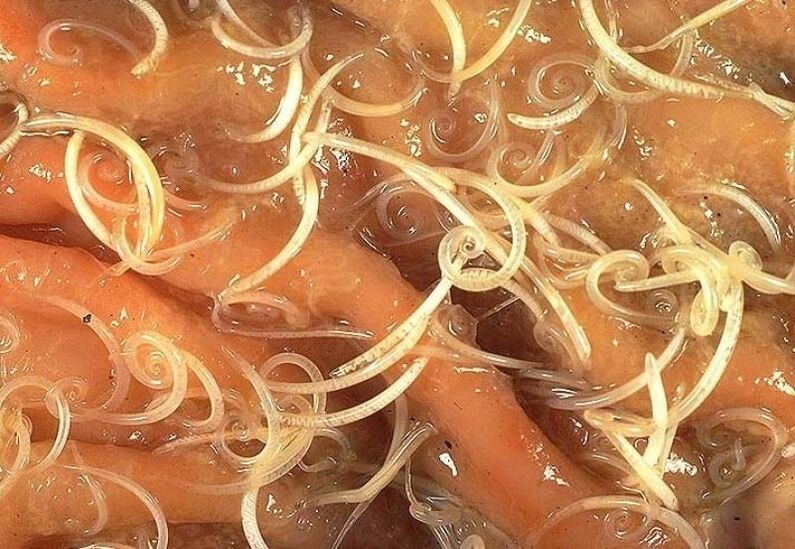
Snoes - what they look like in the human body (photo of worms)
speaker- These are one of the most common human parasites that are a round worm (nematode).Most of the time, infection with needleworms occurs in children, but also occurs in adults.
The pen is a white parasite, small and round.The individuals of the female individuals have dimensions: 8-13 mm length, 0.5 mm thick, an elongated shape and a straight tail, at the end.
This characteristic of the tail of the female parasite explains its name - "cutter" from the word "Sharp".The male individual is much smaller: its length is 2-5 mm, the thickness is 0.2 mm, the tail is bent, in contrast to female pinworms.
The human invasion has the name of the name and mainly occurs with the non -compliance with personal hygiene rules (inadequate hands washing).Basically, the pinworms live in the small section of the intestine and in the upper part of the large intestine, but in some cases they can also migrate to other organs and organs systems.

The female helminth, which has been fallen in the human body and mate with the male representative of the nematodes, walks into the thick department of the intestine, where it receives the necessary nutrients for life and maturation of eggs from undeserved food residues.
After 4 weeks, the female cutter begins at a speed of 12 cm per hour in the rectum, crawls out of the anus and lays about 5000 to 15,000 eggs in the perianal region, which are fully matured after 4-6 hours and are ready for another life cycle.
This process can be accompanied by itching that encourages an infected person to comb the anus, and thus to the further spread of parasites that fall under the nails under the nails, into the hands of other people (especially for children who are very close to each other) and do not always observe personal hygiene rules).
Infection with pinworms comes from one person to one person through the dust with the parasite eggs, objects that the patient touched.Good eggs can also be transmitted to food with cockroaches and flies.
In addition, eggs remain on linen, clothing, beds, which explains their quick distribution.Due to the fact that the life cycle of the worm is very fleeting and an infection comes from a person to one person, it is quite difficult to get rid of parasites, since the personal objects of the patient are required in addition to taking anthelmint medication and insulation from other nematode media.
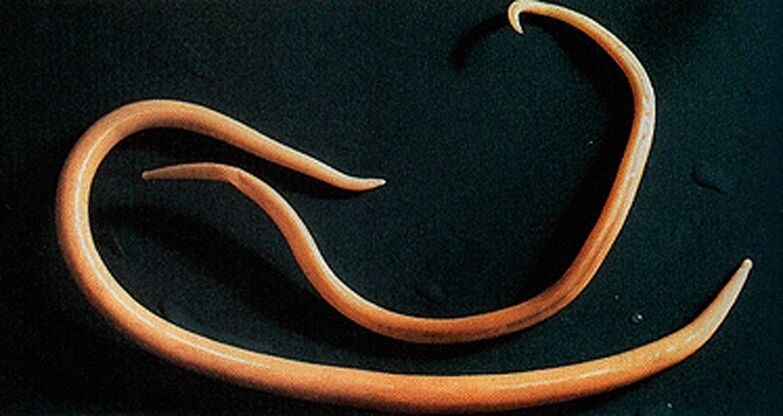
Askarides - what they look like in the human body (photo of worms)
Askarida-Thies is a large parasite of a spindle-shaped shape of a red-yellow color that reaches an adult state of 40 cm (women) and 15-25 cm (men).Without suction cups or other fixing devices, Ascarid can move independently towards the food masses.Eggs that were laid down by the female parasite are distinguished with feces.
The acadosis infection occurs when swallowing mature eggs together with water or unwashed vegetables and fruit on which floor particles are available.After the eggs had penetrated the intestine, they come out of them maturated larvae.
Then they reach the heart into the intestinal wall after blood flow and fall into the lungs from there.Due to the pulmonary alveola, the Larve of the Ascarida penetrates the oral cavity through the airways.
In the intestinal phase of their existence, ascarids can penetrate the closest holes with the ability to expand spiral movements.This characteristic of the parasite often leads to the development of fairly serious complications (mechanical jaundice or pancreatitis)
After repeated swallowing, the parasite reaches the small intestine, where it develops into an adult.The worm lives for 12 months, then dies and stands out with feces.One or more hundred people can live in the intestine of an owner.
Allergens can cause serious allergic reactions from Ascarides.A large number of adults can cause intestinal obstruction, and worms that have penetrated the airways sometimes cause suffocation.

VlasovSov - what they look like in the human body
BlacovyvThey often live in the southern regions because the eggs of this worm love warmth.Most infections are observed in rural areas.Vlass -Kopf -ier -egg live in the ground.
Invasia occurs through the hands, dirty particles of the earth, poorly washed vegetables and fruit.As a result of an infection, an illness occurs - trichocephalose.Vlashev parasitates in the intestine.This worm causes anemia because it feeds on human blood and severe abdominal pain.
For the diagnosis of trichocephalose, the rectum and the sigmoid intestine are examined with a special device (rectoroscopy).Thus, accumulation of parasites are found in the intestine.Treatment of the invasion is long because the wounds are protected by a thick shell.
The parasite eggs have emerged from feces, but they are very small, they cannot always be seen even under a microscope.Only with a very strong invasion is it possible to recognize eggs when analyzing feces.In shape you look like a barrel, have a brownish yellow color.
The eggs are holes on 2 pages.How do worms look in the feces?It is very difficult to find them alive in intestinal movements, since the blazoles cannot live outside the human body for long.Only with Anthelmintic therapy can be seen in the feces of the dead worms of white color.
Liver bacon - as it looks in the human body
A parasite that causes opisthorchiasis is a flat worm that reaches a length of 7 to 20 mm.
In the acute phase of helminthiasis, the patient has pain in the upper abdomen, body temperature increases, nausea, muscle pain, diarrhea and rashes.The parasite larvae begin to develop after the eggs fall into fresh water (from the swallowed snails).Then penetrate into the body of the fish (carp, cross carp, brags, cockroach).
Human infection occurs when you eat infected fish meat that has not subjected sufficient heat treatment.The larva of the liver bomb from the small intestine penetrates the bile ducts into the gallbladder and repairs there with two suction cups.
The chronic course of opisthorchiasis manifests itself through symptoms of hepatitis, inflammation of the bile ducts, cholecystitis, impairment of the digestive tract, nerve disorders, weakness and increased tiredness.The parasite is a drive for the development of irreversible changes, and even after its designation, the patient does not pursue chronic inflammatory processes and functional disorders.
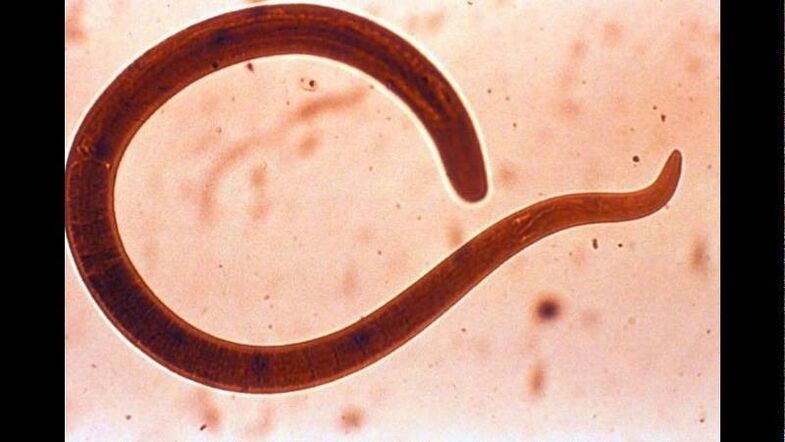
Trichinella - what does the human body look like (photo of worms)
The causal means of trichinellosis is a small round helminth that reaches 2-5 mm long.Infection occurs when the use of poorly fried meat (pork, bear boy, wild boar) is used.The parasite larva in the intestine in 3-4 days turns into the state of the sexually mature individual.
The life expectancy of the worm is 40 days that the parasites die.Larvae drive the intestinal wall and penetrate into the bloodstream and are worn in all organs of the human body and settle in the muscles.In this case, the breathing and facial muscles as well as the muscles ado bends of the limbs are most often affected.
In the first days after the invasion, patients complain of abdominal pain.
After about 2 weeks, the body temperature rises to 39-40 s, itchy rashes occur on the skin, muscle pain develops and the face swells.
During this period there is a considerable risk of death in massive infections.The recovery occurs after about a month.The parasite is encapsulated in spiral shape, according to which it dies within two years.
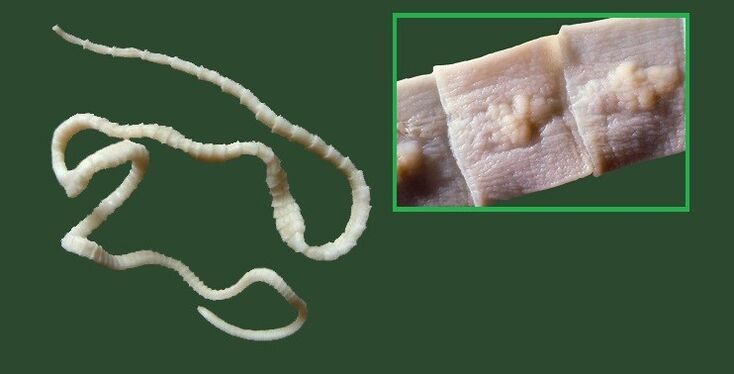
Wide ribbon - what it looks like in the human body
This is one of the largest helminths that reach a length of 10 to 20 meters.The disease caused by this parasite is called dipillobotriosis.The worm development cycle begins with freshwater fish or crustaceans.
The parasite is attached to its wall and grows to a sexually mature individual for 20 to 25 days.
The larva enters the human body, which is the last owner of a wide band with a caviar or infected fish fillet.
Diffillobotriosis goes against the background of disruptions in the digestive tract and the B12 deficiency anemia.
Echinococcus - what it looks like in a person's body
For this parasite, one person is an intermediate floor.The worm parasitates in the human body in the form of Finn.The last owner of Echinococcus is a wolf, a dog or a cat.
The infection is in contact with animals and environmental objects with the handful of Echinococcus eggs.After entering the intestine, oncospheres (six black larvae) develop from them.They enter the bloodstream from the intestine and are worn throughout the body.
The “favorite” parasitis of the worm are liver and light.In these organs, the larva becomes a Finn (echinococo cyst), which gradually increases in size to destroy the nearby substances.
In the diagnostic process, echinococcosis is often confused with a tumor of benign or malignant origin.In addition to the mechanical exposure (squirting organs and blood vessels), a echinococcal rupture sometimes occurs.This condition can cause a toxic shock or the formation of several new cysts.
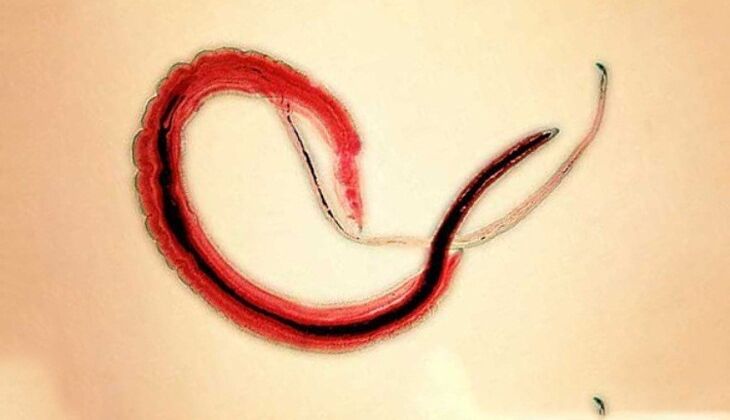
Alveococcus - what it looks like in the human body
This parasite, which is seen as a variety of echinococci, is the cause of one of the most dangerous helminthia (alveococcosis), which is similar in severity with cirrhosis and liver cancer.The infection occurs with the penetration of oncosphere (eggs with mature larvae) into the intestine.
This parasite, which is considered a variety of Echinococcus, is the cause of one of the most dangerous helminthia (alveococcosis)
There the embryo comes out of the egg and, installed in the intestinal walls, penetrates into the bloodstream.In addition, the parasite spreads through all tissue and organs of the body (most often located in the liver).The main level of development on the larvae (a multi -chamber bladder, Laurelozyst) begins there.
Each chamber contains an embryo head of a parasite that continues to develop.Lavrocists are very aggressive formations that constantly grow due to increasing bubbles and have the ability to germinate cancer metastases into the liver.
Necrotic changes are exposed to tissue due to the impairment of the blood vessels.Alveokk open near structures and forms fibrous knots with the inclusions of multi -chamber bubbles.This disease can take several years in which it requires mandatory surgical intervention.
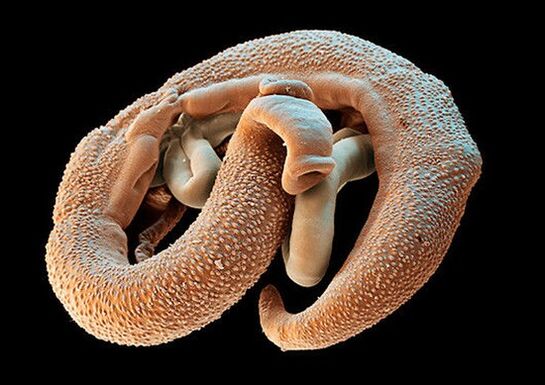
Schistosoma - what about the human body?
Schistosoma - A blood collector belongs to the class of trematodes, depending on the species causes various schistosomosis.This is a flat, separate helminth, which reaches 4-20 millimeter length, 0.25 mm wide.The body of the schistosome is equipped with the 2nd suction cup cup and stomach and is located near each other.Schistos women are longer and thinner than men.There is a longitudinal shortage on the male body so that it holds the female.Your eggs with a diameter of 0.1 mm, oval shape on the surface of one of the poles are a large spike.
The human worms of the schistosomes in the role of the last owner choose people in their organisms, which they parasitize in small veins of the large intestine, the abdominal cavity, the uterus and the bladder.Worms feed on blood and sometimes absorb nutrients through the cuticles.The eggs with Schistos are transported into the intestine and the bladder, where they ripen and stand out with feces or urine.A larva - Miucidius, his intermediate host - comes out of the eggs in the freshwater waters.In Mollusk's body, Metacaria is developing into curial bodies in 4-8 weeks.
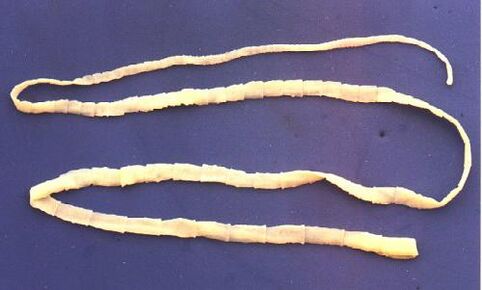
Pork strength - what about the human body?
The pig tapeworm like the bull on the body has 4 suction cups, but in addition the body of the helminth is equipped with a double hook.Stroges reach two to three meters in length.The pig tapeworm has an ovary of three dops, on each side the uterus has 7 to 12 branches.A characteristic characteristic of this helminth is the ability of segments to crawl out of the anus.After the external output, your shell will be dry and bursting, so that Helminthen eggs reach the outer environment.The intermediate master of the tapeworm can be pigs and one person.
The main owner is one person.The intestinal parasites in humans include pork tapeworm, the helminth is located in the patient's intestine, where he lays his eggs.Infections occur when invasive meat is used.
Which doctor you contact with worms to contact us
If an infection with worms is suspected, it is necessary to consult a specialist for medical diseases, helmintologists Or a parasitologist.You can contact a specialist for infectious diseases via infections with parasitic worms or protozoa.
Or a parasitologist.You can contact a specialist for infectious diseases via infections with parasitic worms or protozoa.
You can only contact a helmintologist if the infection is suspected by parasitic worms (pinworms, ascarides, feathers, opisthorchiasis, etc.).
You can contact a parasitologist in cases where the protozoa infection is suspected - Lamblia, toxoplasmes and amoebas.
If the parasite is not located in the lumen of the intestine or stomach, but in other organs (e.g. lungs, liver), you can contact a specialist who deals with the diagnosis and treatment of diseases of this organ.For example, with opisthorchiasis, this is that you can also contact a gastroenterologist or hepatologist and with Echinococcosis to a lung.




















